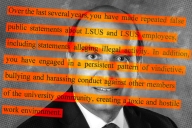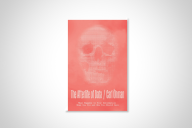You have /5 articles left.
Sign up for a free account or log in.
Without expecting it, and even without recognizing it at first, I found myself standing in front of the Unabomber’s cabin a couple of years ago. Not in its original setting, of course. When the Federal Bureau of Investigation arrested Theodore Kaczynski outside Lincoln, Mont., in 1996, it seized as evidence not only his papers and bomb-making materials but the building itself, which is now on display at the Newseum in downtown Washington as part of an exhibition on the media and the FBI.
The visitor can peer into the cabin from its doorway but not go inside. The shelves are empty -- frustrating for anyone curious about the 200 books in the Unabomber’s library -- and no effort has been made to reconstruct whatever few conveniences the hermit allowed himself. (Most of Kaczynski’s belongings were auctioned off by the government in 2011.) What’s on display, then, is less a crime scene than a shell -- rugged and sturdy but emptied of anything that might convey the sense that it was once a little world unto itself. Or rather, the fortress of someone at war with the society outside it.
Manhunt: Unabomber, an eight-episode dramatic miniseries on the Discovery Channel, wrapped up its final chapter last week. It is now available for download and binge-watching, though I’ll advise against doing so. With all the talk of how we’re living through a golden age of television drama, it’s hard to start watching something potentially interesting without bringing a lot of raised expectations to the table -- even when it’s a true-crime drama for which almost everyone viewing knows how the case will end.
Indeed, last year’s The People vs. O.J. Simpson told precisely such a story, and handled it well. Long-form television seems particularly suited for writers and actors trying to create fairly well-rounded or complex characters. The People vs. O.J. Simpson did so with figures who had, in several cases, stamped themselves indelibly on the media record as self-caricatures.
By contrast, the Unabomber case somehow avoided creating any celebrities -- not even the lead character. Kaczynski’s hostility to industrial civilization most definitely extended to the mass media, at least once he got his manifesto into print; his writings while in prison have mostly been published by anarchist and primitivist sympathizers. (It is hard to think of anyone so famous with so minimal a public presence, with the possible exception of Thomas Pynchon.) And the recent memoir by his brother, David, seems driven by conscience and grief rather than any need for acclaim. More than 150 people worked on the Unabomber task force, and the FBI would prefer you remember it as a team effort. Pages discussing the Unabomber case on the agency’s website take care not to imply that anyone in particular assumed the role that Efrem Zimbalist Jr. once played.
For most of the viewing public, then, Manhunt: Unabomber tells a tale that is neither completely new nor overfamiliar. On the major points it seems to be reasonably accurate about where the case stood as of 1995 and how it was solved by the following year. Some liberties are taken with chronology, though nothing egregious. The makers stress the role of one investigator, James R. Fitzgerald, whose linguistic analysis of the Unabomber’s writings helped identify Kaczynski as the author. A more ambitious telling of the story would present it from a number of points of view. But the tendency to idealize a single heroic figure is probably coded into our cultural DNA, hence not surprising.
And yet Manhunt: Unabomber is roughly seven-eighths pure dreck. The potential to imagine characters in any depth goes to waste (with one exception, to be discussed presently) while the scriptwriters move around their cardboard cutouts who mouth lines copied from The Big Book of Cop Show Clichés, first edition.
They also tap into a reliable vein of pop-culture tropes about profiling -- seeing it as not just a combination of deductive and inductive analysis but evidence of some kind of deep psychic connection between investigator and (usually) serial killer. Now, it is true that Fitzgerald was trained as a profiler by the FBI, and the Unabomber’s career was fatal enough for him to count as a serial murderer. But Fitzgerald’s “Using a Forensic Linguistic Approach to Track the Unabomber” (appearing in an anthology of papers on profiling) makes clear that any intuitive finesse he brought to the investigation came from painstaking, systematic, full-immersion scrutiny of the texts.
Even with access to software “by which words or phrases could be accessed easily,” he writes, “I still felt it a worthwhile exercise for me to go through the manifesto page by page, paragraph by paragraph, and assemble my own glossary/index. It took the better part of a solid week, but I managed to create a 15-page alphabetically and chronologically based product …”
Manhunt gives the impression that Fitz (as he’s called) more or less invented forensic linguistics while working on the Unabomber case and met with constant resistance from the rest of the FBI. Every 15 minutes or so, someone higher in the pecking order will bang a desk and say, “Again with your nutty ideas about forensic linguistics? We don’t have time for your cockamamie theories, Fitz! We need evidence! Hard evidence! Bring me the name of a suspect, not any more of this innovative and hence easily dismissed methodology you keep practicing!”
OK, not every 15 minutes, or in exactly those words, though that’s what it feels like. But every indication in Fitzgerald’s paper -- and in the chapter on the Unabomber investigation in his recently published memoir -- is that his colleagues were supportive of his approach and interested in his findings. He also acknowledges that the first forensic-linguistic analysis of the Unabomber’s prose was conducted by Roger Shuy, a professor of linguistics he consulted at Georgetown University, where Fitzgerald later wrote a master’s thesis on language and gender differences.
The violence and mayhem unleashed by Kaczynski tends to obscure the fact that much of the drama around his life and capture was internal -- intensely so, in ways that prove difficult, though not impossible, to depict on the TV screen. The makers of Manhunt: Unabomber appear not so much to avoid the challenge as remain oblivious to it. The emotional struggle within the rest of the Kaczynski family is never more than a plot point to be hit in passing. Fitzgerald’s consuming interest in details of the Unabomber’s idiolect is expressed mainly by having Fitz run around waving pieces of paper. (It also keeps him from noticing that the hot young linguistics graduate student on his team is eager for tactile communication.)
But to give credit where it’s due, the sixth episode stands in contrast to everything complained about here. It follows Kaczynski for a couple of days as he writes a letter to his brother and occasionally talks with the tiny number of people who constitute his social world. He has memories of being a human subject for a truly hideous psychological experiment at Harvard during his teenage years. Scenes in his cabin make it feel like a bunker. He attends to the very fine details of assembling a bomb that, upon finishing, he packages for shipment and then slides underneath what turns out to be his bed.
The final scene of him going to sleep poses the question of how to understand what he’s done: as a sign of perfect confidence in his own skills as a bomb maker or a gesture of total indifference to the possibility of accidental suicide. I suppose that is a variant of the more familiar question of whether he should be understood as evil or sick, but the image presents it in a strong and memorable way. You could do worse than to watch this episode of Manhunt: Unabomber and skip the rest.








